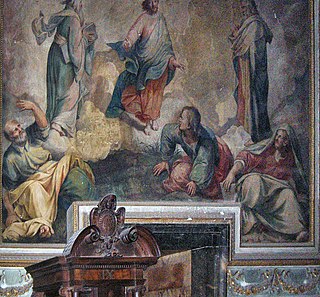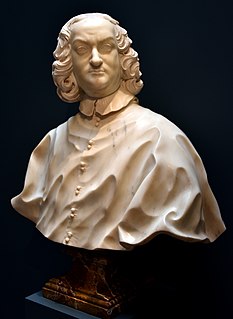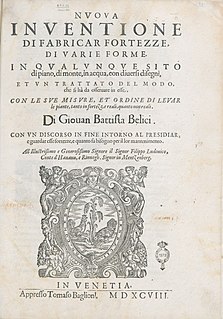Related Research Articles

Piermaria Bagnadore, also called Pietro Maria Bagnatori, was an Italian painter, sculptor, and architect of the late-Renaissance period.

Durante Alberti was an Italian painter of the late-Renaissance period.
Matteo di Guaro Allio (1605–1670) was an Italian sculptor of the Baroque period, active mainly in Padua. Born in Scaria, in Lombardy, he produced some of the sculpture for the lateral pilasters of the Capella dell'arca of the Basilica of Saint Anthony of Padua. He worked there alongside Girolamo Pironi. Matteo was the brother of Tommaso Allio, also sculptor and architect in Padua.
Andrea di Alessandro was an Italian sculptor of the Renaissance period. He was born in Brescia and active there and in Venice during the latter half of the 16th century. He was a pupil of Alessandro Vittoria, and his masterpiece is the bronze candelabra for the church of Santa Maria della Salute in Venice.

Domenico Auria was an Italian architect and sculptor of the Renaissance period, active in Naples. He was a pupil of Marliano da Nola. He is also known as Giovanni Domenico or Giovan Domenico Auria, or Domenico d'Auria.

Giovanni di Balduccio was an Italian sculptor of the Medieval period.

Pietro Balestra was an Italian sculptor of the late-Baroque period. He was born in Siena, and was best known for his work in marble in Dresden, including a Meleager slaying the Calydonian Boar; Venus and Cupid, and Boreas and the Rape of Orithyia.

Antonio Bambocci (1351?–1421?) was an Italian painter and sculptor of the Gothic period, active in and near Naples.
Francesco Baratta the elder was an Italian sculptor of the Baroque period.
Pietro Baratta (1659–1729) was an Italian sculptor of the Baroque period, active in Venice.
Annibale Maggi was a Venetian architect of the Renaissance period. He designed and help build the loggia del Consiglio in Padua in 1493, and was the architect of the house of San Giovanni degli Specchi. Also known as Annibale Bassano or da Bassano.
Giovanni Battista Bellandi was an Italian sculptor, active in Milan for its elaborately decorated Cathedral.

Marco Beltrame was an Italian sculptor of the Baroque period, active mainly in his birthplace, Venice.
Damiano del Barbiere was an Italian stuccoist and sculptor of the Renaissance period, recruited by Primaticcio to help in the labors at the palace of Fontainebleau.
Guglielmo Bergamasco was an Italian architect and sculptor of the Renaissance period.

Paolo Emilio Besenzi (1608–1656) was an Italian painter, sculptor, and architect of the 17th century, born and active in Reggio Emilia. He lived and worked as a painter, sculptor and architect in Reggio Emilia in the first half of the 17th century. According to Tiraboschi he was sent to France for a short time, at the court of Louis XIII, who would have named him a knight. He trained with Francesco Albani, and was a friend and companion of Lionello Spada. He was buried in the now demolished church of Santa Maria Maddalena, for which he designed the main altar.
Francesco Brambilla was an Italian sculptor of the Renaissance period, active in Milan, in the decoration of its massive gothic Cathedral.
Fra Simone da Carnuli was a (Genoese) painter. He was a Franciscan friar of Genoa. He painted several pictures for his convent, two of which are dated 1519, representing the Last Supper and Preaching of St. Anthony. He painted architectural designs and bird's-eye views with figures seen from an aerial perspective.

Giovanni Battista Belluzzi (1506–1554), also known as Giovanni Battista di Bartolomeo Bellucci and as Il Sanmarino, was a Sammarinese architect and military engineer. He was born in San Marino on September 27, 1506 and at 18 years of age was sent by his father to Bologna, to learn commerce under Bastiano di Ronco, a merchant of the Guild of Wool. After two years, he returned to San Marino, where he set up a wool business of his own. His first wife, Cagli, died shortly after they were married. His second wife was the daughter of Girolamo Genga (1467–1551). The couple lived with Girolamo Genga, from whom Giovanni learned architecture. In 1541, his second wife died, leaving Giovanni to raise two sons. In 1543, Giovanni entered into the service of Cosimo I de' Medici, Grand Duke of Tuscany, as an engineer. He designed fortifications for Florence, Pistoia, Pisa and San Miniato and also wrote a book on military architecture. He was wounded in the siege of Montalcino and was killed by enemy fire in a fortress of Aiuola.
Stefano Ticozzi (1762-1836) was an Italian art historian.
References
- ↑ Encyclopedia Treccani Dizionario Biografico degli Italiani - Volume 26 (1982), entry by Stella Rudolph.
- ↑ Ticozzi, Stefano (1830). Dizionario degli architetti, scultori, pittori, intagliatori in rame ed in pietra, coniatori di medaglie, musaicisti, niellatori, intarsiatori d’ogni etá e d’ogni nazione' (Volume 1). Milan: Gaetano Schiepatti. p. 334.